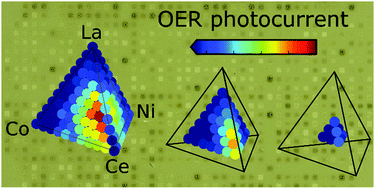Development of solar fuels photoanodes through combinatorial integration of Ni–La–Co–Ce oxide catalysts on BiVO4†
Abstract
The development of an efficient photoanode remains the primary materials challenge in the establishment of a scalable technology for solar water splitting. The typical photoanode architecture consists of a semiconductor light absorber coated with a metal oxide that serves a combination of functions, including corrosion protection, electrocatalysis, light trapping, hole transport, and elimination of deleterious recombination sites. To date, such coatings have been mostly limited to simple materials such as TiO2 and Co-Pi, with extensive experimental and theoretical effort required to provide an understanding of the physics and chemistry of the semiconductor-coating interface. To provide a more efficient exploration of metal oxide coatings for a given light absorber, we introduce a high throughput methodology wherein a uniform BiVO4 thin film is coated with 858 unique metal oxides covering a range of metal oxide loadings and the full Ni–La–Co–Ce oxide quaternary composition space. Photoelectrochemical characterization of each photoanode reveals that approximately one third of the coatings lower the photoanode performance while select combinations of metal oxide composition and loading provide up to a 14-fold increase in the maximum photoelectrochemical power generation for oxygen evolution in pH 13 electrolyte. Particular Ce-rich coatings also exhibit an anti-reflection effect that further amplifies the performance, yielding a 20-fold enhancement in power conversion efficiency compared to bare BiVO4. By use of in situ optical spectroscopy and comparisons between the metal oxide coatings and their extrinsic optical and electrocatalytic properties, we present a suite of data-driven discoveries, including composition regions which form optimal interfaces with BiVO4 and photoanodes that are suitable for integration with a photocathode due to their excellent power conversion and solar transmission efficiencies. The high throughput experimentation and informatics provides a powerful platform for both identifying the pertinent interfaces for further study and discovering high performance photoanodes for incorporation into efficient water splitting devices.


 Please wait while we load your content...
Please wait while we load your content...